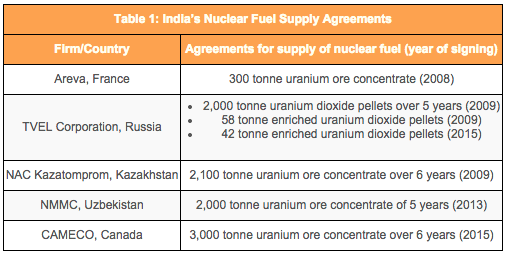CAMECO will supply India with 3,000 tonnes of uranium over six years, enough to keep 1,700 megawatts (MW) of India’s 5,780 MW of nuclear-power plants running.
A similar agreement was concluded with Uzbekistan in 2013, and India is trying to close a fuel supply agreement with Australia, which has the world’s largest reserves of uranium. These agreements are in addition to those already inked with Russia and Kazakhstan.

Source: Press Information Bureau
These agreements may be part of the solution to India’s air pollution problems. India is trying to move away from using coal, which accounts for almost 80% of India’s electricity generation and is highly polluting.
Nuclear power accounts for 3.5% of India’s electricity generation and 1.3% of India’s total energy consumption, but the government has set some ambitious targets.
It wants to triple nuclear power plant capacity by 2024 from 4,780 MW in 2014 (5,780 MW now). A more recent and extremely ambitious goal is a target of 63,000 MW by 2031-32.
Nuclear energy does not emit carbon dioxide and other pollutants – major concerns, given the air-quality crisis in Indian cities and the widespread economic effects of local and global climate change.
However, nuclear power comes with potentially catastrophic safety risks, which India hopes to keep under check. Other countries weigh the risks similarly, although Germany intends to close nuclear plants by 2022.
Source: BP Statistical Review of World Energy 2014
China, the biggest user of coal globally (and the biggest polluter) is also trying to aggressively move to nuclear power. China’s target: 58,000 MW of nuclear power by 2020 and 150,000 MW by 2030 – this is a key component of China’s plans to increase the share of non-fossil fuels (excluding coal, oil, gas) from less than 10% now to 15% by 2020 and 20% by 2030.
The problem with nuclear fuel
Arranging affordable nuclear-fuel supply has been a challenge for India.
India is currently saddled with 23,000 MW gas-based power plants, almost idle for want of fuel.
Electricity from gas is also 2-3 times costlier than nuclear power depending on gas prices, a concern in an emerging economy.
But scaling up nuclear energy is a problem. Of 5,780 MW of nuclear-power capacity that India operates, 3,380 MW relies on imported fuel. Domestic uranium supplies are enough only for the remaining 2,400 MW.
Historically, India’s nuclear power programme has been constrained by a uranium shortage. The programme started to grow only after the Indo-US nuclear agreement of 2008, which allowed India to import nuclear fuel and ink agreements with fuel suppliers (see Table 1).
India has 3,800 MW of nuclear-power capacity under construction and another 43,100 MW is proposed. Of this, 1,000 MW of under-construction capacity and 31,900 MW of proposed nuclear capacity will be built in collaboration with companies from the US, France and Russia. For these reactors, the contractors must provide fuel throughout a plant’s life, which can last up to 50 years.
For the remaining 14,000 MW of indigenously designed nuclear capacity, India needs to source fuel. Domestic uranium supplies, as we explained, are inadequate.
Moreover, domestic uranium also has other uses – to build nuclear weapons – and using it only for fuel is not something India would like to do.
This article was originally published on IndiaSpend.com, a data-driven and public-interest journalism non-profit.










